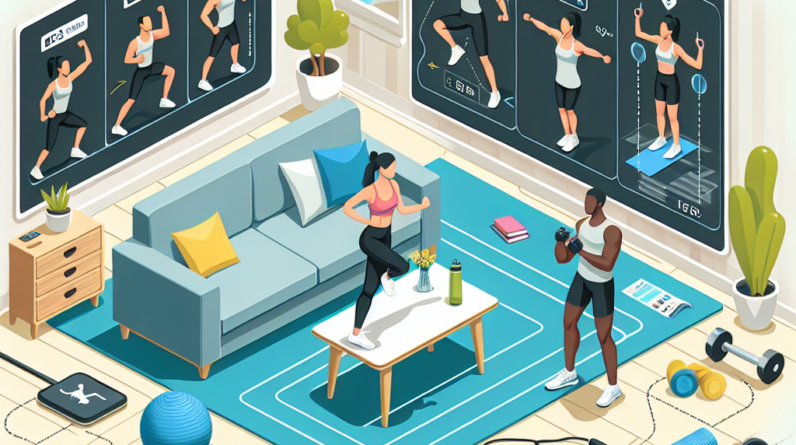
1. Define Your Goals
Understanding Your Fitness Objectives
Setting clear fitness goals is the first step in creating your workout routine. Personally, I find it super helpful to differentiate between short-term and long-term goals. Short-term goals might be something like completing a certain number of home workouts each week, while long-term goals could involve achieving a particular weight or mastering a difficult exercise.
Get a Huge Discount and Bonus! Try for 90 Days Risk Free
Think about what you truly want to accomplish. Do you want to lose weight, build muscle, increase endurance, or simply feel more energetic? Pinning down these objectives helps in tailoring your workouts to suit your needs.
You’ll also want to consider your current fitness level. Are you a complete beginner or someone with some experience? This truth will guide the intensity and complexity of your routine.
Writing Down Your Goals
Jotting down your goals can make a world of difference. One tool I’ve found super effective is creating a vision board or even just a plain old list. Writing things down holds me accountable and gives me something tangible to refer back to.
Include specifics like the timeframe you want to achieve these goals in. For example, “I want to run 5K in three months.” This specificity makes your goals more actionable and gives you a clear target.
Additionally, it can be motivating! Every time I glance at my list, I feel pumped and ready to tackle my next workout. It’s about making it real for yourself!
Breaking Down Your Goals into Smaller Steps
Once you’ve set your goals, it’s time to break them down into manageable steps. For instance, if your goal is to do 10 push-ups in a row, maybe start by doing sets of 5 and gradually increase them over time.
This breakdown not only makes the journey less overwhelming but also allows for celebrating small victories, which is key for motivation. Every little progress is worth a cheerful fist pump from me!
Lastly, revisit your goals every month or so. Adjust as needed. Life happens, and sometimes we need to tweak our expectations—no shame in that!
Get a Huge Discount and Bonus! Try for 90 Days Risk Free
2. Assess Your Space and Equipment
Understanding Your Workout Environment
Next up, let’s talk about your workout space. I usually pick a spot at home where I can spread out and not worry about knocking anything over. It could be your living room, a spare room, or even the garden if the weather’s nice.
Make sure your space motivates you! I like to add some personal flair, like my favorite workout posters or a little plant for that fresh vibe. If I feel good about my space, it sets the mood for a killer workout.
Don’t stress about needing a fancy gym setup! Sometimes simple things like a yoga mat, resistance bands, or even bodyweight exercises can do the trick. Use what you have and get creative!
Choosing Your Essential Gear
In terms of equipment, you don’t need to go overboard. I learned the hard way that fancy gadgets and gizmos can collect dust. Focus on a few essential items that you can use in various workouts. I swear by my dumbbells and resistance bands.
Need a Serious Energy BOOST? Huge Discount Try for 90 Days Risk Free
Consider adding a jump rope or exercise ball, too—these items are super versatile and can amp things up a notch. Just make sure whatever you choose, it’s something that excites you to use.
Having access to good workout gear can also enhance the experience. I find it energizing to wear comfortable, motivating workout clothes. It makes a big difference in how I feel while exercising.
Maximizing Your Space for Different Workouts
I’m all about making the most of what you have. If you live in a smaller space, look for exercises that require minimal room. Bodyweight exercises like squats or lunges are perfect for cramped quarters.
If you have access to an outdoor space, don’t overlook that option! Running or doing calisthenics outside can be rejuvenating and boost my mood tremendously.
Spatial awareness is key! I often set boundaries in my workout area; it helps me focus and stay organized, and I’m less likely to trip over my own feet in the middle of a burpee!
3. Create a Balanced Routine
Understanding Exercise Types
A balanced workout routine incorporates strength training, cardio, and flexibility exercises. For strength, I alternate workouts focusing on major muscle groups, allowing time for recovery.
Cardio exercises are essential, too—these can be anything from jumping jacks to dancing like no one’s watching. I’ve found that mixing it up keeps me from snoozing through my workouts.
Lastly, flexibility and mobility work can be a game-changer. Stretching or yoga enhances recovery and keeps me feeling limber. I try to dedicate at least one day a week to focus solely on these aspects.
Sample Weekly Structure
When it comes to putting it all together, I like to visualize my week. A sample structure could look something like this: strength training on Monday, cardio on Tuesday, rest on Wednesday, repeat, and include flexibility on the weekends!
This kind of breakdown not only ensures I hit every muscle group but also gives me something to look forward to each day. It’s also important to be flexible—if I’m feeling jazzed one day, I might switch things up!
Every week might not look the same, and that’s totally fine. The key is consistency over perfection. I believe in crafting a routine that feels right for me and sticking with it as best I can.
Staying Flexible with Your Schedule
One thing I’ve learned is that life can throw curveballs, so staying adaptable is crucial. If something comes up and I can’t exercise at my usual time, I’ll fit in a quick session whenever I can.
Good Health Solution is Easier Than Most People Think!
Take a Look for Yourself!
Moreover, if a certain routine isn’t feeling right, don’t hesitate to switch it up! The best workout is one that feels enjoyable and keeps you excited. I remember one week, I switched my jogs to HIIT workouts for a change of pace, and it felt refreshingly tough!
This adaptability helps avoid burnout and keeps the motivation alive. If I’m itching for a change, I embrace it rather than stick to rigid plans.
4. Track Your Progress
Keeping a Workout Journal
Tracking progress is something I can’t recommend enough! Keeping a workout journal is a great way to reflect on what I’ve done, how I’ve felt, and what I can improve on.
When I review my entries, I often find patterns—like days I feel stronger or when a certain exercise I struggled with gets easier. It’s all about celebrating those wins, no matter how small!
Plus, it encourages me to try new things or adjust my routine accordingly. It’s like having my own personal coach cheering me on through my journey!
Measuring Different Aspects
Progress isn’t just about weight or aesthetics; there are so many facets! I track things like how many reps I can do, distance run, or even how I feel after a session. It’s all data that adds to my insight.
Even mood changes count! If I notice I’m feeling more energetic or happier overall, that’s a win in my book. We often overlook mental benefits, but they’re crucial.
I also like to periodically take progress photos. It’s fascinating to visually see how my body changes over time. I wouldn’t recommend a focus just on weight, but seeing those changes can be pretty motivating!
Adjusting Goals Based on Progress
After tracking for a while, I often reevaluate my goals. It’s natural to outgrow initial objectives or discover new interests. For instance, if I start really digging strength training, I might adjust to focus on that more intensely.
Adjusting goals also helps keep me engaged. If I feel I’ve hit a plateau, a simple tweak can make a world of difference. Whether it’s increasing weights or trying different exercises, keep the momentum going!
Remember, it’s all about progress, not perfection. It’s okay to readjust timelines and expectations. I always remind myself to enjoy the ride.
5. Stay Motivated and Accountable
Finding Your Workout Tribe
Let’s face it, working out at home can be lonely sometimes! That’s why I love connecting with friends, either in person or virtually. We sometimes share our routines, support each other’s goals, and hold each other accountable.
Creating a small group can boost motivation and make workouts a bit more fun. I’ve found that sharing playlists or challenges keeps things lively and helps me stay committed.
Even following fitness influencers online can be inspiring. It’s motivating to see how others crush their goals, and they often have awesome tips to share!
Setting Reminders and Routines
I’ve also used technology to my advantage. I set reminders on my phone to remind me when it’s workout time, just like I’d schedule any other activity. This creates a sense of obligation and helps me stay dedicated.
Creating daily rituals around my workouts, like having a protein shake afterward or taking a post-workout selfie, reinforces the behavior, making it feel like an enjoyable habit instead of a chore.
Consistency, my friends, is key! If I stick to my scheduled time, it becomes a part of my day, much like drinking my morning coffee.
Celebrate Your Achievements
Lastly, let’s celebrate those achievements! Whether it’s completing your first full week of workouts or hitting a new PR, it’s crucial to recognize and reward yourself.
As simple as these wins may seem, they propel you forward. Treating yourself to a new workout outfit or a relaxing bubble bath can be the perfect incentive.
Also, share your achievements with friends or on social media! I’ve found that when I post about my progress, it creates a little accountability circle and elicits positive reinforcement from others. It’s all about building that positive vibe!
FAQ
1. How often should I work out at home?
It really depends on your goals and fitness level, but a good starting point is 3-5 times a week. Just be sure to listen to your body!
2. What if I have no equipment?
No worries! There are tons of bodyweight exercises like push-ups, squats, and lunges that can provide an amazing workout without equipment.
3. How long should my workouts be?
Anywhere between 20-60 minutes is a solid range. It’s more about the quality of the workout than the quantity of time spent.
4. What should I do if I feel unmotivated?
Try switching things up—new workouts, different music, or find a workout buddy. Often, just getting started can help rekindle motivation!
5. Can I see progress working out at home?
Absolutely! Many people see fantastic results working out at home. Consistency, effort, and a well-rounded approach will definitely yield positive changes.







